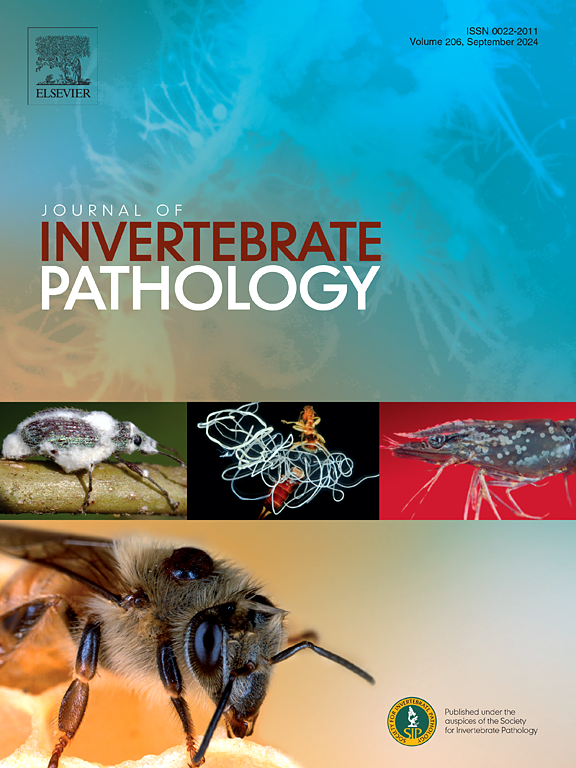通过过表达角质层降解内几丁质酶的基因工程提高球孢白僵菌芽孢的毒力。
IF 2.4
3区 生物学
Q1 ZOOLOGY
引用次数: 0
摘要
昆虫致病真菌的基因工程与液体发酵培养的速效感染性胚孢子相结合,为开发针对广泛节肢动物害虫的更有效的真菌杀虫剂提供了一种创新方法,从而最大限度地减少了对合成化学杀虫剂的过度依赖。本研究对球孢白僵菌(Beauveria bassiana,子囊菌科:冬虫冬草科)进行了基因工程改造,将其内源Chit1基因的多个拷贝整合到其基因组中,目的是增强囊胚孢子的毒力。对两个过表达Chit1的高毒力突变体的基因组分析发现,在它们的基因组中分别有4个和2个拷贝,分别被命名为OEBbChit1-3和OEBbChit1-5,与野生型(WT)菌株相比,它们的基因显著上调了约 ~ 3- 5倍,从而证实了基因表达和几丁质酶活性的升高与目标基因的过表达一致。与野生型相比,OEBbChit1突变体通过自然表皮感染途径将胚孢子接种于mellonia幼虫时,平均致死时间(LT50)缩短至75.7 %,平均致死浓度(LC50)降低约4.6 log10倍。在所检测的表型性状中,氧化应激在高毒力突变体中更为明显,其体外囊胚孢子产量略低于WT菌株。此外,与WT和模拟对照相比,高毒力突变体感染增加了总血细胞密度,从而引发了快速的昆虫免疫反应。总的来说,我们的研究结果提供了令人信服的证据,证明了一种基于球孢白僵菌遗传改良的创新策略,即在速效芽孢中过度表达天然几丁质酶,从而在真菌发育过程中以最小的有害表型效应增强毒力。本文章由计算机程序翻译,如有差异,请以英文原文为准。

Enhanced virulence through genetic engineering of Beauveria bassiana blastospores by overexpression of a cuticle-degrading endochitinase
Genetic engineering of entomopathogenic fungi combined with fast-acting infective blastospores grown by liquid fermentation offers an innovative approach to develop more efficient mycoinsecticides targeting a broad spectrum of arthropod pests, thus minimizing the over-reliance on synthetic chemical insecticides. In this research, Beauveria bassiana (Ascomycota: Cordycipitaceae) was genetically engineered by integrating multiple copies of an endogenously derived Chit1 gene, which encodes a constitutively expressed chitinase putatively involved in insect cuticle degradation, into its genome, with the aim at enhancing blastospore virulence. Genomic analysis of two highly virulent mutants overexpressing Chit1 identified 4 and 2 copies of this gene in their genomes, designated as OEBbChit1-3 and OEBbChit1-5, which were significantly upregulated by approximately ∼ 3- to 5-fold higher compared to the wild-type (WT) strain, thus confirming elevated gene expression and chitinase activity consistent with overexpression of the target gene. Compared with the WT, the median time to lethality (LT50) of the OEBbChit1 mutants was shortened to 75.7 %, and the median lethal concentration (LC50) decreased approximately 4.6-log10 fold when blastospores were applied to Galleria mellonella larvae via the natural cuticle infection route. Among the phenotypic traits examined, oxidative stress was more pronounced in the highly virulent mutants, which exhibited slightly reduced blastospore production in vitro than the WT strain. Moreover, infections by the highly virulent mutants increased the density of total hemocytes relative to the WT and mock control, thus triggering a rapid insect immune response. Collectively, our findings provide compelling evidence of an innovative strategy based on the genetic improvement of B. bassiana by overexpression of the native chitinase in fast-acting blastospores, thus leading to enhanced virulence with minimal detrimental phenotypical effects in fungal development.
求助全文
通过发布文献求助,成功后即可免费获取论文全文。
去求助
来源期刊
CiteScore
6.10
自引率
5.90%
发文量
94
审稿时长
1 months
期刊介绍:
The Journal of Invertebrate Pathology presents original research articles and notes on the induction and pathogenesis of diseases of invertebrates, including the suppression of diseases in beneficial species, and the use of diseases in controlling undesirable species. In addition, the journal publishes the results of physiological, morphological, genetic, immunological and ecological studies as related to the etiologic agents of diseases of invertebrates.
The Journal of Invertebrate Pathology is the adopted journal of the Society for Invertebrate Pathology, and is available to SIP members at a special reduced price.

 求助内容:
求助内容: 应助结果提醒方式:
应助结果提醒方式:


